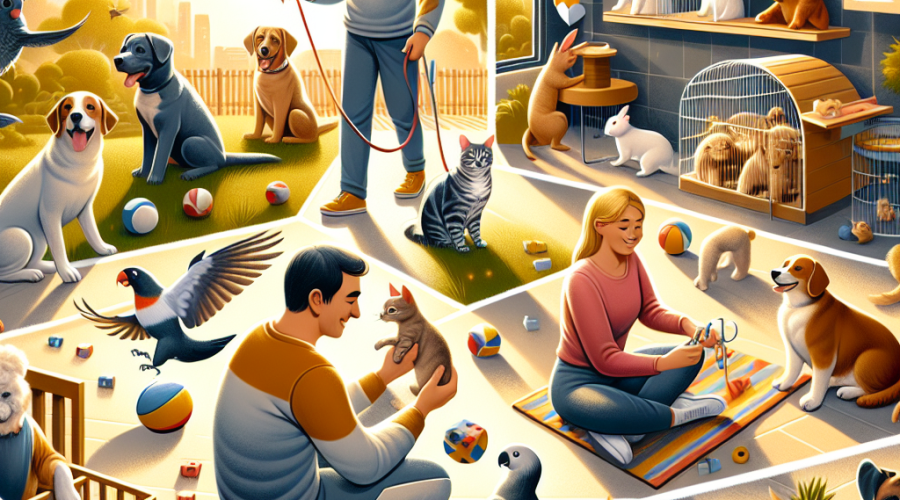Eradicate Pet Loneliness with Companion-Focused Strategies
In the bustling world we live in, it’s not just humans who can feel the pangs of loneliness. Our furry friends, ever so loyal and dependent on our company, can experience a similar sense of solitude when left to their own devices. It’s a heart-wrenching thought, isn’t it? Imagining your beloved pet pining for interaction while you’re away at work or busy with life’s myriad demands.
However, pet loneliness isn’t an insurmountable challenge. There are numerous strategies that pet owners can employ to ensure their companion animals lead a fulfilled and happy life, even in their absence. Understanding your pet’s needs for companionship is the first step towards crafting a life that’s brimming with joy for both of you.
It’s essential to realise that different pets have different social needs. A dog, for example, is a pack animal by nature and craves interaction and socialisation, whereas a cat may be more independent but still appreciates the occasional fuss and playtime. The key is to tailor your approach to the individual pet, taking into account their species, breed, and unique personality.
Creating a stimulating environment is paramount in combating pet loneliness. This goes beyond just having toys available—although toys are a brilliant start. It’s about crafting an environment that engages your pet’s senses and intellect. For dogs, puzzle feeders can provide mental stimulation as well as a tasty reward. Cats, on the other hand, may enjoy high perches and scratching posts that cater to their climbing instincts and need to maintain their claws.
Interactive toys that mimic the movements of prey can be particularly effective for cats, engaging their natural hunting instincts. For our canine companions, toys that encourage them to think and work for a treat can keep them occupied for hours. And what about birds or small mammals? They too thrive in enriched environments that mimic their natural habitats, with plenty of opportunities for foraging and exploration.
One cannot underestimate the power of social interaction. For pet owners who spend long hours away from home, arranging playdates or considering daycare options for their pets can be a lifesaver. Dogs especially benefit from the chance to socialise with their kind, which not only alleviates loneliness but also ensures they are well-adjusted and behave appropriately around other dogs.
For those who have a single pet and are pondering the idea of adding another furry member to the family, it can be a delightful way to provide constant companionship. However, it’s crucial to introduce new pets thoughtfully, ensuring compatibility and gradually acclimatising them to each other’s presence to foster a harmonious bond.
What about the role of technology in all this? In today’s digital age, pet owners have an array of gadgets at their disposal to stay connected with their pets. Pet cameras with two-way audio allow you to check in on your pet, offer reassuring words, or even dispense a treat. It’s a fantastic way to bridge the gap between your departures and returns, letting your pet know they’re never truly alone.
And then there’s the simple power of routine. Pets, much like humans, find comfort in predictability. Establishing a daily routine of walks, playtime, and cuddles can provide a reassuring framework that helps your pet feel secure. Even when you’re not there, the familiarity of their schedule can be a source of comfort.
It’s vital, though, not to forget the value of quality time spent together. Our pets live for those moments when we’re fully present with them. Whether it’s a leisurely walk in the park, an intense play session, or just quiet companionship, these moments can fortify your pet’s emotional well-being and deepen the bond you share.
Pet loneliness is a tender issue that requires a heartfelt response. By understanding your pet’s social needs, providing a stimulating environment, fostering social connections, and making the most of technology and routine, you can create a life that’s rich and fulfilling for your beloved companion. Because at the end of the day, isn’t their happiness intertwined with our own? After all, a content pet makes for a contented heart.
FAQs
Q: How can I tell if my pet is feeling lonely?
A: Signs of pet loneliness include noticeable changes in behavior, such as excessive vocalisation, lethargy, or destructive activities. If your pet seems withdrawn or exhibits a significant change in eating or sleeping patterns, they might be experiencing loneliness.
Q: What are some effective strategies to alleviate loneliness in pets?
A: Providing regular interactive playtime and mentally stimulating toys can help keep your pet engaged and reduce feelings of isolation. Also, consider scheduling playdates with other pets or enrolling your furry friend in a pet daycare for social interaction.
Q: Can adopting another pet help reduce loneliness for my current pet?
A: Yes, bringing a second pet into the home can provide companionship and reduce loneliness, but it’s important to match their temperaments and introduce them gradually to ensure a harmonious relationship. Always assess your current pet’s personality and needs before deciding to adopt a companion for them.
Q: How does creating a routine help combat pet loneliness?
A: Establishing a consistent routine with set times for meals, walks, play, and attention can provide a sense of security and predictability for your pet, making them feel less anxious and alone. Consistency in daily activities helps build a stable environment that can mitigate feelings of loneliness.
Q: Are there any technology-based solutions to help keep my pet company when I’m not at home?
A: Yes, there are several tech gadgets available, such as pet cameras with two-way communication and treat-dispensing features, which allow you to interact with your pet remotely. Interactive toys and smart feeders can also simulate your presence by providing entertainment and regular feeding times.

